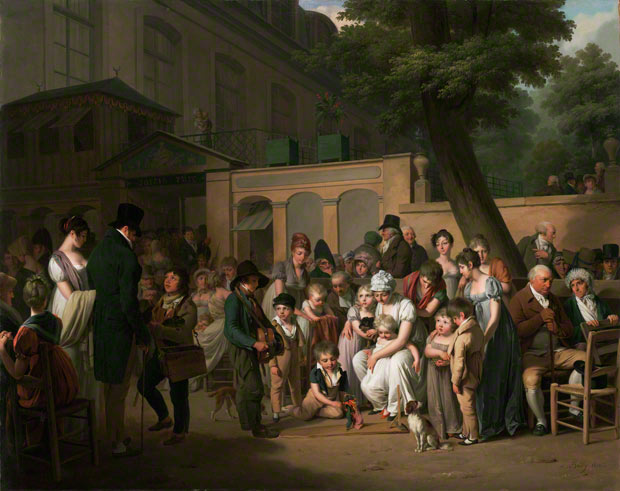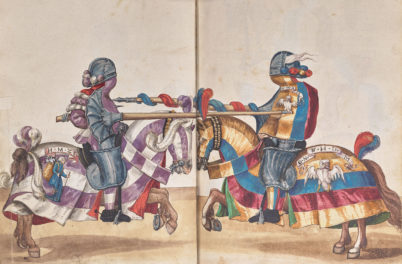
Entrance to the Jardin Turc, Louis-Léopold Boilly, 1812. Oil on canvas, 28 7/8 x 35 7/8 in.
More than 60 people sit, chat, and play in this elaborate composition outside the entrance to the Jardin Turc, or Turkish Garden Café, in early-1800s Paris. The café was known for its spacious gardens, exotic pavilions, and excellent ice cream, but the painter, Louis-Léopold Boilly, shares with us only the exterior wall of this famed hot spot, focusing on the spectacle of the bustling curbside.
It’s rich with abundant detail and precision. The closer one looks, the more characters begin to reveal themselves. Several figures return the viewer’s gaze—many quite intensely.
We make eye contact with the following people, moving left to right in the painting: a man in the doorway, and a couple in the ticket window shaded by the striped-green awning; next, a couple in the center—a man resting his chin in his hand wearing a bicorne and a woman in a lavender feathered hat; then, an older woman just beyond the tree; coming to an end with the artist himself, in spectacles and a top hat.

Why do these characters look back at us? Perhaps the painting isn’t actually about a café, or gardens, or middle-class leisure, or ice cream. It’s about viewing. And that’s precisely why Boilly chose this exterior view.
The real pleasure of the Jardin Turc was seeing and being seen. Some characters, like the aristocratic woman standing at the left, bask confidently in Boilly’s spotlight (and our gaze). Others retract into anonymity and shadow, preferring viewing over being on display. And still others, like the street urchin in the left foreground, are forced by economics to thrust themselves into view.
And we’re seeing and being seen, too. Through a space of nearly 200 years, this painting is looking back at us.
Becoming part of this scene is thrilling. It reminds me that interacting with human beings is—or can be—a beautiful experience.
What do you think: Are you, the viewer, part of this artwork? Does an artwork need a viewer to come alive?
Question of the Week is a series inspired by our Masterpiece of the Week tours, offered daily at 4:00 p.m. Featuring an open and upbeat discussion among visitors and gallery teachers, the tours feature a new object and pose a new question each week.




Interesting — These figures making eye contact are all in the background or middle ground, and somewhat obscured by shadow. Lurkers, if you will. Is there some significance to this?
I definitely think an artwork needs a viewer to come alive. If a painting hangs on a wall and no one is around to see it, does it still exist? Sure. But does the painting matter? Not really.
I suspect the artist is using these direct gazes as a vehicle for eliciting response from the viewer. Yes, certainly involving the viewer as an invitation to casting judgement or reflect on a particular element of the scene. I frequently do that in my own narrative photographs in which certain recurring characters stare back at the viewer in a manner that asks, “What do you think about what you see?”
In Boilly’s painting, this technique is achieved to perfection.
Anna – I found that quite interesting myself! Those figures are clearly such an important part of the work, but ‘hiding’ them might question their significance. They are certainly not at the forefront of all the action, rather all evenly placed behind that ledge which divides the foreground and middleground. It seems as though Boilly asks us to spend time with his painting, to discover more as we keep looking. And I think by looking and discussing we do bring it to life in a way. At least that’s what I think Boilly had in mind!
John – I have to agree. Patrons and street-performers alike, from the youngest to the eldest, come together for the viewer’s pleasure – both those represented and us as onlookers. I believe the artist was very conscious of the viewer, as well as himself, especially by inserting his own self-portrait into that same narrative. It reads as a wonderful triangular relationship between the artist, the subject, and beholder.
I agree with Anna, above, that the people looking back at me are so subtle, or in the shadows, that I almost wonder if I was supposed to notice them. Is it more obvious if you’re in front of the actual panting than it is in this image I am seeing online?
There’s also so much activity going on that it is easy to miss these onlookers. In fact, as I look closer, the people that the artist decided to spotlight are not those looking back at us – the boy with his chickens and the woman with children above him, the little dog in the foreground, and the tall young woman on the left, and the two older men in white wigs on the far right.
It all makes me wonder if the artist is trying to send a subversive message. And this makes me think of Marshall McLuhan’s theories of figure and ground http://en.wikipedia.org/wiki/Figure_and_ground_%28media%29
Susan – Boilly’s painting is just teeming with detail, many of which you note here, and others that are easy to miss upon first glance. It may have to do with what I mention above to Anna. Also, the areas of strong contrast – such as the extreme light tones we see around the neck of the standing young lady at left, or the woman and child in the center wearing white dresses, and even the white shirts, scarves, and stockings of the elderly couple at right – rhythmically pop and initially capture our attention. Therefore, the figures returning our gaze recede in their softer tones, and are undoubtedly much subtler. But if you’re in Los Angeles, you must definitely come see for yourself!
Of course the viewer is part of the artwork — art is meant to be seen, if only by the artist him- or herself.
My first reaction on seeing this picture the day it went on display was to smile, and it quickly became one of my favorites in the collection. The color and detail grabbed and held my attention immediately, and I can still almost hear the din of the crowd and the music from the boy’s hurdy-gurdy. The expressions of the many people in the painting seem typical of what you would see if you were to walk by a similar gathering in a popular outdoor venue today, including people-watching as suggested by the figures looking out at the viewer. I’m also struck by the fact that almost everyone in this picture is involved in some way with someone else; there are relatively few figures who are not interacting in some way with at least one other.
One of the most intriguing things about this picture for me, aside from the wonderful hat worn by the young puppeteer, is why three of the children surrounding the puppets seem to be looking toward the aristocratic couple on the left. This mystery is one of the many things that keeps me coming back to this painting and spending a few moments in 19th-century Paris.
May be it takes time to enter in a piece of art. To become part of the showed. Sometimes I got this experience with American twentieth century art painting too. It is as if you share in the depicted. It’s a question of feeling.
When I first read the question my immediate thought was that of course the viewer is an integral part of the artwork. I’m not entirely sure that’s the case, though. I’m reminded of the artwork of the Collection de l’Art Brut in Lausanne, Switzerland and, in particular, that of Edmund Monsiel. Monsiel was a shut in suspected of being an undiagnosed schizophrenic who created his art as an expression of the turmoil he was going through. I think some art such as his can be powerful as an outlet for the artist without regard to any potential viewers. Monsiel never shared his art while he was alive and it wasn’t until after his death that it was discovered. I’m not sure he ever had the intention for it to be shared at all but even if it had been left undiscovered to rot in his attic I think the works would have still held weight as powerful pieces of artistic expression.
He was trying to make the first interactive painting. The interaction was like this: The characters in the painting tried to ask the viewers, “What are you staring at?” or the viewers may think that “Why those characters looking back?” or may lead to other questions…